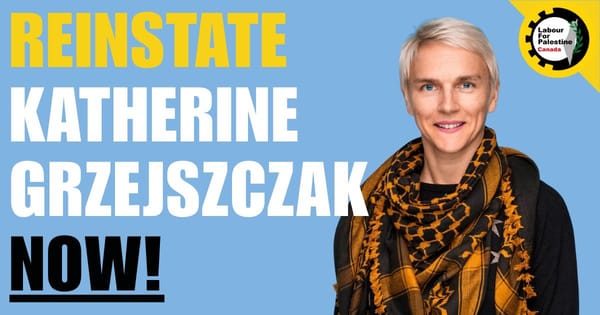
As I wrote about last time, many labour folks were understandably fired up about Uber’s latest attempt to undermine workers’ rights across Canada. This week I thought I’d highlight some good pro-worker proposals.
Last week, the Centre for Future Work released a new report outlining ways to expand “worker voice” — the ability of union and non-union workers to exercise greater power — in the post-pandemic economy.
The report, authored by Jim Stanford and Daniel Poon, comes at a critical moment. As I argued in the first edition of Class Struggle, workers have borne the brunt of risk and sacrifice throughout the pandemic. We desperately need improvements in labour and social policy to protect workers’ health and safety and increase their bargaining power. Stanford and Poon’s report should serve as an impetus to begin addressing these issues.
I anticipate that some on the socialist left will scoff at the notion of worker ‘voice.’ Indeed, as Stanford and Poon retrace in their report, ‘worker voice’ has historically been an elastic concept, at times taken up disingenuously by neoclassical economists and human resource managers more concerned with union avoidance than worker power.
Yet, thinking broadly about how we create the conditions for all workers to speak up without repercussions and have their issues addressed at work is an important exercise. There’s a world of difference between self-styled ‘enlightened’ employers willing to hear individual worker suggestions and robust institutions that enhance the capacity of workers to exercise voice and power.
There are immediate and historical reasons why expanding worker voice requires our attention now. The ongoing pandemic means workers must have the autonomy and capacity to wield power on the job, for their safety and ours. In the long-term, there’s an urgent need to plan for a green transition at the industrial and macroeconomic levels, which must actively involve all impacted workers. From the level of the workplace, to the sector, to economic and social policy, workers require the power to realize their role as the agents of social change.
Unions and the labour movement have been, and will remain, the primary institutional vehicles for exercising working-class voice. Yet the historical weakness of organized labour, perhaps most revealed by the decline in private sector union density and Canadian workers’ low level of strike activity, also highlights the need to augment workers’ ability to exercise voice throughout the economy.
Getting workers into unions is more than just a matter of effective organizing. As Stanford and Poon make clear, labour law reforms, such as universal card check certification, are needed to make it easier for workers to form unions and collectively bargain. As I’ve pointed out elsewhere, this ‘chicken and egg’ problem (needing labour law reform to organize workers, but needing to organize workers to get the reforms) is a considerable obstacle.
Moreover, increasing union density, while inarguably important, is not on its own enough. Deepening union democracy and strengthening connections with workers outside of the organized labour movement are vital and complementary objectives.
Finding ways to increase the power of the unorganized and the precariously employed is therefore particularly pressing. The historical legacy of the bifurcation between employment law, which stipulates minimum employment standards, and labour law, which governs access to unionization and collective bargaining, means that workers without union protections — the overwhelming majority — often face the abuses of the boss alone.
Greater numbers of workers are now unorganized and reliant on employment standards legislation, such as minimum wage and maximum hours laws, as their only protection at work. Though these pieces of legislation were never particularly robust, over the years Liberal and Conservative governments across the country have either let them atrophy or actively weakened what protections they do offer.
Under the canard of improving business confidence and investment, governments allowed minimum wage rates to stagnate, reduced or eliminated access to overtime pay, and undermined the ability of workers to file complaints and get redress by reducing labour standards inspections.
The challenges of increasing worker voice and power under these circumstances are great. But having clear policy ideas to orient our demand is an important first step. Toward this end, I want to amplify three recommendations made by Stanford and Poon (though I encourage all Class Struggle subscribers to read the full report).
First, Stanford and Poon argue we should fight to make it much more difficult for employers to fire workers. This important reform could have a number of positive implications for working-class power. Whether workers are trying to form a union, individually attempting to file a complaint with a Ministry of Labour or organizing direct action against an employer without a union, they face the ever-present threat of being fired.
Outside of the federal jurisdiction in Canada, the non-unionized can have their employment terminated without reason so long as the employer gives the legally-stipulated notice (or pay in lieu of notice). Although human rights codes and ‘unfair labour practice’ prohibitions ostensibly prevent firings based on discrimination or as retaliation for union activity, workers in vulnerable situations face such dismissals all too frequently. The very threat of ‘the sack’ has a chilling effect on organizing.
We could address this head-on by ending the power of employers to unilaterally fire workers. The Centre for Future Work report calls for extending just-cause dismissal protections to non-unionized workers throughout Canada. This could help create the conditions for workers to feel more secure in fighting for their rights at work, as well as during organizing drives.
More broadly, just dismissal protections limit the unilateral right of capital and its managers to use and dispose of labour as they please. Just-cause provisions for non-unionized workers are already a feature of many other European countries’ systems of labour protection.
Australia also requires employers to show just cause for dismissal and its Fair Work Ombudsman oversees a universal arbitration system through which workers can file complaints and win compensation.
As well, during the 2020 Democratic primary, Bernie Sanders’ “Workplace Democracy Plan” called for abolishing “at-will employment” and instituting just-cause dismissal federally in the United States. This idea is in the air. We should fight for it here in Canada too.
Second, I was especially drawn to Stanford and Poon’s call for creating statutory mechanisms for worker voice. As they point out, we already use this model in our approach to occupational health and safety (OHS).
Across Canada, governments mandate that workplaces with 20 or more employees — 10 or more in Newfoundland and Saskatchewan — must have an OHS committee where workers can have a say in issues affecting workplace health and safety. We could require similar committees for employment standards compliance and give workers on these committees ready access to state enforcement when violations take place.
However, in pursuing this we would need to rethink the OHS minimum staffing thresholds if labour management committees (LMCs) were to monitor employment standard laws. Given that small workplaces are more likely to violate workers’ rights, exempting them from mandatory LMCs would undermine the latter’s very purpose.
Establishing statutory rights to worker power through mandated LMCs at present seems remote. But organizing around this demand could eventually bear fruit under even a mildly progressive provincial government. Mandatory LMCs for enforcing labour standards could then be a meaningful way for workers with limited access to unionization to exercise power on the job.
Third, Stanford and Poon call for borrowing from and expanding on Quebec’s ‘decree’ system, wherein the government extends union-negotiated collective agreements to new workplaces across a specified industry. This eliminates having to establish bargaining units and negotiate contracts at the level of the workplace in hard to organize industries.
Dating to the 1930s, this model has been effective in sectors characterized by small workplaces, high levels of sub-contracting and ownership structures that make unionization difficult. As the Centre for Future Work report indicates, the 14 decrees currently in place in Quebec cover more than 9,000 workplaces and approximately 75,000 workers who would otherwise be unlikely to have the protection of a collective agreement.
Currently, three sector-level decrees in security, building and cleaning services, and motor vehicle repair shops account for the majority of covered workers. While the use of decrees in Quebec has declined, the practice could be revived and introduced in other provinces if the labour movement organized sufficient pressure in support of this reform. An expanded version of this model in other provinces could also cover highly competitive industries typified by small worksites, such as restaurants and hospitality establishments, delivery and local courier services, and home-based and other para-public health care.
For the socialist left, organizing unions and building the institutional capacity of the labour movement remain vital. Yet the above reforms and the many other proposals outlined by Stanford and Poon could also allow workers to exert meaningful power and voice at work. We would do well to take their proposals seriously and organize to demand governments implement them.






